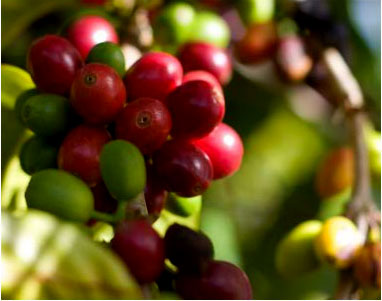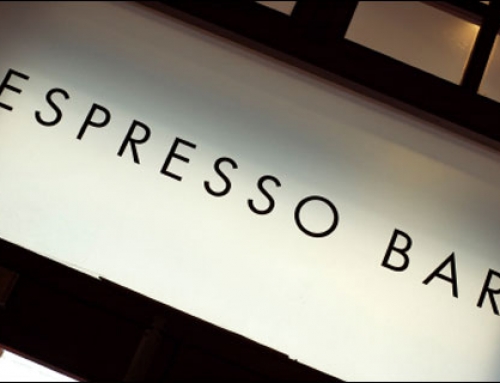I was lucky enough to be given a personal tour around one of the most promising up-and-coming Australian coffee plantations/roasters a few days ago. The plantation was called Red Door Coffee and the owner is Brett Luker. Red Door is situated a few kilometres off the Pacific Highway just past Ballina in a little place called Fernleigh. Ballina is just near Byron Bay on the NSW far north coast, about 10 hours north of Sydney and only a couple of hours south of Brisbane.Here is a boutique plantation with 4000 Arabica trees where coffee is hand-picked, hand processed and hand roasted on a Dietrich roaster. (I’ve seen tour companies that advertise coffee plantation trips in PNG and India for tens of thousands of dollars but to be quite honest, we have similar plantations employing similar farming methods on our doorstep. And the coffee is good!)Ten or fifteen years ago people would have laughed if you said Aussies grew decent coffee. “Labour’s too expensive and we don’t have the highlands that support the finest Arabica,” they used to say. Well, it is true that our labour is expensive (which is why these plantations often employ backpackers to hand-pick their coffee) but the lack of altitude does not seem to be an issue with the sort of temperatures that our coffee grows in and the rich volcanic soil and long growing season that Australia offers.
Red Door and some other Aussie plantations could use expensive contract machine harvesters but given that the coffee cherry needs to be de-skinned or pulped within 24 hours of picking and demucilaged after that, the harvesters would leave these farmers with way too much coffee to process by natural fermentation in that short window. So hand-picking is preferred and as well as the fact that it allows farmers to harvest when it suits them, it gives a much better strike rate of only harvesting ripe cherries that will ensure that the best flavoured beans are achieved.
Brett says that perfecting the taste of coffee really has a lot to do with the roasting process but after I heard him discuss the cultivation process I think that there is definitely an art to this as well. Selective hand-picking, having the right pulping equipment, the right fermentation methods, sun drying the beans, having the right de-hulling equipment, having the right storage facilities and executing all of these processes at the right time all play a part in the preparation of the green bean for roasting. It’s a long road from the tree to the green bean stage but what I gleaned from Brett is that no corners can be cut if you want to end up with a palatable coffee.
It’s true that a lot of the plant stock that grows in northern NSW is similar. And because the soil and climate conditions are all similar, the average punter would probably think that all Byron Bay coffee would therefore taste similar but that is just not true and a lot of the difference comes in how scientifically you treat the roasting process according to Brett. I have come across some roasters who believe that you can just throw in 10kg of green beans into a roaster and roast solely according to colour. In other words, you pull out a sample from the trier on the roasting machine during the process and watch the colour of the beans go from green to the particular shade of brown that matches your standard. These roasters put the roaster on a set temperature in the drum and eject the beans when their eyes tell them they are “done”. A more scientific and ultimately more consistent approach, according to Brett and his roasting friend and mentor Greg Jansen, is to vary the temperature at set times and by set increments whilst still keeping an eye on the colour of the bean as it roasts. The challenge with coffee is that no two batches are ever the same (variables like bean size, bean density, bean hardness and water content ensure this) but according to Brett, if you chart a particular roast profile and be fairly true to this each time you roast, you can achieve great consistency.
An added bonus to my visit was seeing the pottery studio on-site that is run by Brett’s partner Brooke. You can see the making of the pottery there as the turning equipment and kiln are right there amongst the finished pieces for sale. Brooke makes some really fantastic, unique pottery that is a great complement to the Red Door Coffee on display and for sale.
It’s definitely worth a stop off if you are travelling through Ballina on the Pacific Highway to or from Brisbane. And if Brett’s around I am sure he will instill his passion for coffee in you just as he did in me.
Families in Europe who are facing various health problem, such families can purchase medicines online without order. In these latter days more than half of men aged 40 to 70 reported some degree of erectile difficulties. Below are four steps about cialis dosage. Let’s find answers to specific questions about ED. While ED is more common among older men, that doesn’t make it ‘normal’. When you order medicaments like Cialis you have to ask your physician about cialis dose. Other question we have to is cialis dosage for ed. A long list of prescription medicaments can lead to erectile disfunction, including definite blood tension drugs, pain remedies, and several antidepressants. Any remedy may cause some side effects. Sometimes side effects can be really dangerous.






Hi there,
Just doing a search and came across your website.
We also grow coffee, process on site and roast, we have around 10,000 trees. It is a lot of hard work but the results speak for themselves. We produce very nice coffee. We grow Condong Range Bourbon.
Dawn